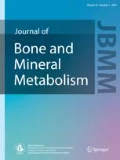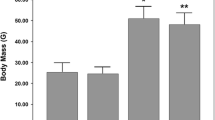Abstract
Resveratrol has gained popularity as an “anti-aging” compound due to its antioxidant and anti-inflammatory properties. Few studies have investigated the role of resveratrol supplementation in the prevention of age-related bone loss and skeletal disuse despite increased inactivity and age-related bone loss in the elderly. The objective of the study was to investigate the effect of resveratrol supplementation on disuse and age-related bone loss. Old (age 33 months) Fischer 344 × Brown Norway male rats were provided either trans-resveratrol (12.5 mg/kg bw/day) or deionized distilled water by oral gavage for 21 days. Rats were hindlimb-suspended (HLS) or kept ambulatory (AMB) for 14 days. Both femora and tibiae were collected. Bone mass was measured by dual-energy X-ray absorptiometry and bone microstructure was determined by micro-computed tomography. HLS of old male rats accelerated loss of bone mineral content, decreased trabecular bone volume per unit of total volume, and increased trabecular separation. Resveratrol supplementation ameliorated bone demineralization and loss of bone microarchitecture in HLS old male rats. The peak force measured by the three-point bending test was reduced (P = 0.007) in HLS/control compared to AMB/control rats. Resveratrol supplementation ameliorated HLS-induced loss of femur strength. Plasma osteocalcin and alkaline phosphatase was higher (P < 0.04) and C-reactive protein was lower (P = 0.04) in old male rats given resveratrol. The bone protective effects of resveratrol appeared to be mediated through increased osteoblast bone formation, possibly due to reduced inflammation. Based on the results, resveratrol supplementation appeared to provide a feasible dietary therapy for preserving the skeletal system during disuse and age-related bone loss.

Similar content being viewed by others
References
Duque G, Troen BR (2008) Understanding the mechanisms of senile osteoporosis: new facts for a major geriatric syndrome. J Am Geriatr Soc 56:935–941
Kanis JA, Johnell O, Oden A (2001) Ten year probabilities of osteoporotic fractures according to BMD and diagnostic thresholds. Osteoporos Int 12:989–995
Inderjeeth CA, Foo AC, Lai MM, Glendenning P (2009) Efficacy and safety of pharmacological agents in managing osteoporosis in the old: review of the evidence. Bone 44:744–751
Ebeling PR (1998) Osteoporosis in men. New insights into aetiology, pathogenesis, prevention, and management. Drugs Aging 13:421–434
Vidavalur R, Otani H, Singal PK, Maulik N (2006) Significance of wine and resveratrol in cardiovascular disease: French paradox revisited. Exp Clin Cardiol 11:217–225
Cottart C, Nivet-Antoine V, Laguillier-Morizot, Beaudeux J (2010) Resveratrol bioavailability and toxicity in humans. Mol Nutr Food Res 54:7–16
Williams LD, Burdock GA, Edwards JA, Beck M, Bausch J (2009) Safety studies conducted on high-purity trans-resveratrol in experimental animals. Food Chem Toxicol 47:2170–2182
Chachay VS, Kirkpatrick CM, Hickman IJ, Ferguson M, Prins JB, Martin JH (2011) Resveratrol – pills to replace a healthy diet? Br J Clin Pharmacol 72:27–38
Dehority W, Halloran BP, Bikle DD, Curren T, Kostenuik PJ, Wronski TJ, Shen Y, Rabkin B, Bouraoui A, Morey-Holton E (1999) Bone and hormonal changes induced by skeletal unloading in the mature male rat. Am J Physiol 276:E62–E69
Habold C, Momken I, Ouadi A, Bekaert V, Brasse D (2011) Effect of prior treatment with RES on density and structure of rat long bones under tail-suspension. J Bone Miner Metab 29:15–22
Momken I, Stevens L, Bergouignan A, Desplanches D, Rudwill F, Chery I, Zahariev A, Zahn S, Stein TP, Sebedio JL, Pujos-Guillot E, Falempin M, Simon C, Coxam V, Andrianjafiniony T, Gauquelin-Koch G, Picquet F, Blanc S (2011) Resveratrol prevents the wasting disorders of mechanical unloading by acting as a physical exercise mimetic in the rat. FASEB J 25:3646–3660
Zhang YB, Zhong ZM, Hou G, Jiang H, Chen JT (2011) Involvement of oxidative stress in age-related bone loss. J Surg Res 169:37–42
Yun AJ, Lee PY (2004) Maldaptation of the link between inflammation and bone turnover may be a key determinant of osteoporosis. Med Hypotheses 63:532–537
Bar-Shai M, Carmeli E, Ljubuncic P, Reznick AZ (2008) Exercise and immobilization in aging animals: the involvement of oxidative stress and NF-kappaB activation. Free Radic Biol Med 44:202–214
Smith BJ, Lucas EA, Turner RT, Evans GL, Lerner MR, Brackett DJ, Stoecker BJ, Arjmandi BH (2005) Vitamin E provides production for bone in mature hindlimb unloaded male rats. Calcif Tissue Int 76:272–279
Boissy P, Andersen TL, Abdallah BM, Kassem M, Plesner T, Delaissé JM (2005) Resveratrol inhibits myeloma cell growth, prevents osteoclast formation, and promotes osteoblast differentiation. Cancer Res 65:9943–9952
Pervaiz S, Holme AL (2009) Resveratrol: its biologic targets and functional activity. Antioxid Redox Signal 11:2851–2880
Institute of Laboratory Animal Resources Commission on Life Sciences (1995) Guide for the care and use of laboratory animals. National Academy Press, Washington, pp 21–55
Morey-Holton E, Globus RK (2002) The hindlimb unloading rodent model: technical aspects. J Appl Physiol 92:1367–1377
Yuan YV, Kitts DD (1992) Estimation of dietary calcium utilization in rats using a biomechanical functional test. Food Chem 44:1–47
Ortoft G, Oxlund H, Jorgensen PH, Andreassen TT (1992) Glucocorticoid treatment of food deprivation counteracts the simulation effect of growth hormone on rat cortical bone strength. Acta Paediatr 81:912–917
Banu J, Wang L, Kalu DN (2002) Age-related changes in bone mineral content and density in intact male F344 rats. Bone 30:125–130
Wang L, Banu J, McMahan CA, Kalu DN (2001) Male rodent model of age-related bone loss in men. Bone 29:141–148
Iida H, Fukuda S (2002) Age-related changes in bone mineral density, cross-sectional area and strength at different skeletal sites in male rats. J Vet Med Sci 64:29–34
Chen H, Zhou X, Emura, Shoumura S (2009) Site-specific bone loss in senescence-accelerated mouse (SAMP6): a murine model for senile osteoporosis. Exp Gerontol 44:792–798
Pearson KJ, Baur JA, Lewis KN, Peshkin L, Price NL et al (2008) Resveratrol delays age-related deterioration and mimics transcriptional aspects of dietary restriction without extending lifespan. Cell Metab 8:157–168
Jee WS, Ma Y (1999) Animal models of immobilization osteopenia. Morphologie 83:25–34
Perrien DS, Akel NS, Dupont-Versteegden EE, Skinner RA, Siegel ER, Suva LJ, Gaddy D (2007) Aging alters the skeletal response to disuse in the rat. Am J Physiol Regul Integr Comp Physiol 292:988–996
Juan ME, González-Pons E, Munuera T, Ballester J, Rodríguez-Gil JE, Planas JM (2005) Trans-RES, a natural antioxidant from grapes, increases sperm output in healthy rats. J Nutr 135:757–760
Vico L, Collet P, Guignandon A, Lafage-Proust MH, Thomas T, Rehaillia M, Alexandre C (2000) Effects of long-term microgravity exposure on cancellous and cortical weight-bearing bones of cosmonauts. Lancet 355:1607–1611
Li XJ, Jee WS, Ke HZ, Mori S, Akamine T (1991) Age-related changes of cancellous and cortical bone histomorphometry in female Sprague-Dawley rats. Cells Mater (Suppl) 1:25–37
Bloomfield SA, Allen MR, Hogan HA, Delp MD (2003) Site and compartment specific changes in bone with hindlimb unloading in mature adult rats. Bone 31:149–157
Hayes DP (2011) Resveratrol and vitamin D: significant potential interpretive problems arising from their mutual processes, interactions and effects. Med Hypotheses 77:765–772
Gropper SS, Smith JL, Groff JL (2009) The fat-soluble vitamins. In: Gropper SS, Smith JL, Groff JL (eds) Advanced nutrition and human metabolism, 5th edn. Wadsworth, Belmont, pp 373–428
Duque G (2008) Bone and fat connection in aging bone. Curr Opin Rheum 20:429–434
Morey E, Baylink DJ (1978) Inhibition of bone formation during space flight. Science 201:1138–1141
Pietschmann P, Skalicky M, Kneissel M, Rauner M, Hofbauer G, Stupphann D, Viidik A (2007) Bone structure and metabolism in a rodent model of male senile osteoporosis. Exp Gerontol 42:1099–1108
Almeida M, Han L, Martin-Millan M, Plotkin LI, Stewart SA, Roberson PK, Kousteni S, O’Brien CA, Bellido T, Parfitt AM, Weinstein RS, Jilka RL, Manolagas SC (2007) Skeletal involution by age-associated oxidative stress and its acceleration by loss of sex steroids. J Biol Chem 282:27285–27297
Xu H, Watkins BA, Seifert MF (1995) Vitamin E stimulates trabecular bone formation and alters epiphyseal cartilage morphometry. Calcif Tissue Int 57:293–300
la Lastra De, Villegas I (2005) Resveratrol as an anti-inflammatory and anti-aging agent: mechanisms and clinical implications. Mol Nutr Food Res 49:405–430
Franceschi C, Valensin S, Bonafè M, Paolisso G, Yashin AI, Monti D, De Benedictis G (2000) The network and remodeling theories of aging: historical background and new perspectives. Exp Gerontol 35:879–896
Cauley JA, Danielson ME, Boudreau RM, Forrest KY, Zmuda JM, Pahor M, Tylaysky FA, Cummings SR, Harris TB, Newman AB (2007) Inflammatory markers and incident fracture risk in older men and women: the health aging and body composition study. J Bone Miner Res 222:1088–1095
Gilbert L, He X, Farmer P, Boden S, Kozlowski M, Rubin J, Nanes MS (2000) Inhibition of osteoblast differentiation by tumor necrosis factor-alpha. Endocrinology 141:3956–3964
Lorenzo J (2000) Interactions between immune and bone cells: new insights with many remaining questions. J Clin Invest 106:749–752
Teitelbaum SL (2000) Bone resorption by osteoclasts. Science 289:1504–1508
Weinreb M, Rodan GA, Thompson DD (1989) Osteopenia in the immobilized rat hind limb is associated with increased bone resorption and decreased bone formation. Bone 10:187–194
Acknowledgments
The authors wish to thank Stephanie Altman for her assistance with the TBARS and total antioxidant capacity measurements, Joan Wright for the ICP analysis of bones, Eric Scheller for technical assistance during the animal surgeries, and Dr. Brenda J. Smith for performing the DEXA and μCT bone analysis. Funding for this study was provided by the West Virginia University Agriculture and Forestry Experimental Station Hatch grant H45.
Conflict of interest
The authors have no conflicts of interest to declare.
Author information
Authors and Affiliations
Corresponding author
About this article
Cite this article
Durbin, S.M., Jackson, J.R., Ryan, M.J. et al. Resveratrol supplementation preserves long bone mass, microstructure, and strength in hindlimb-suspended old male rats. J Bone Miner Metab 32, 38–47 (2014). https://doi.org/10.1007/s00774-013-0469-2
Received:
Accepted:
Published:
Issue Date:
DOI: https://doi.org/10.1007/s00774-013-0469-2




